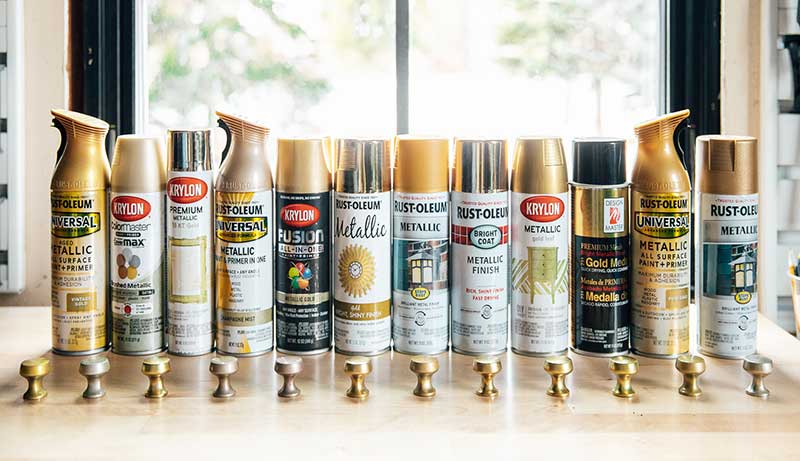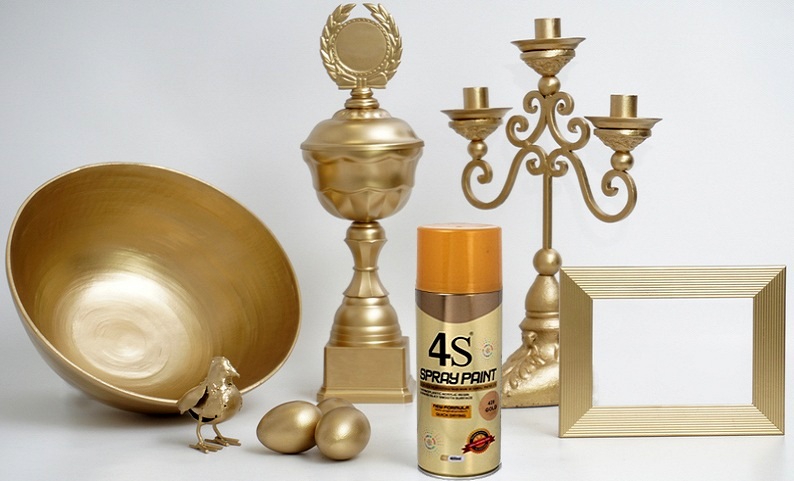Can you spray paint brass? How to spray paint brass? Everything you need to know about spray painting brass materials will be explained below.
Yes, you can spray paint brass, but there are some general guidelines to remember. Make sure to purchase the appropriate spray paint first, as not all of them may be appropriate for use on brass-colored materials.
Additionally, make sure that you are completing the required steps to prepare your brass surface for spray painting and that you use the proper application technique when doing so.
Table of Contents
Things You’ll Need:
- Oil-rubbed bronze spray paint
- Spray paint gun
- Drop cloth or large piece of cardboard
- Steel wool, grade 000
- Toothpicks (for swing pulls like these)
- Metal Primer
How to Spray Paint Brass?
Get the Surface Ready for Painting
Preparing the surface of the object you wish to paint should be your first step. This step is very important because it will determine how the finished product will look.
The brass object should be placed in a well-ventilated area, as per our recommendation. Always leave the doors and windows open while painting in a well-ventilated space. You are being shielded from dangerous paint fumes by doing this. You should also shield yourself by putting on gloves, a mask, and other safety equipment.
Start scrubbing with steel wool right away. In addition to getting rid of the corrosion and dirt, this gives the paint a good surface to adhere to. Make sure to concentrate your scrubbing on the areas with the most corrosion. After cleaning, use a damp cloth to remove any remaining residue.
Clean the Surface
To get rid of any grease, oils, or other contaminants on the surface, use a degreaser. As their presence on the surface will prevent your paint from adhering properly, getting rid of these undesirable elements is crucial. Apply a degreaser to a cloth and wipe the entire surface you plan to paint. Lastly, use a cloth soaked in water to wipe the surface clean.
Apply the Primer on the Brass
The appropriate primer for the task must be chosen. A self-etching primer, also referred to as a bonding primer, is among the best brass primers.
This is how things get done when you have the proper primer and paint.
Hold the primer 6 to 8 inches away from the surface while giving it a good shake, advises Available Paints. Apply a thin, even coat of primer in a sweeping motion, moving from side to side.
Allow the primer to settle for roughly. 24 hours or according to the manufactures instructions. It has enough time to dry completely because of this.
Spraying the Paint on the Brass Item
We’ll assume that you’ve already decided on your favorite color of spray paint. Additionally, you should pick long-lasting, durable paint. Enamel paint, items made of acrylic or oil, or hard-drying paint are some of the best choices to take into account.
Apply thin coats of paint using the same technique after the primer coat has cured and dried. To apply an even, thin coat of paint, sweep the paint from side to side while holding a spray gun 6 to 8 inches away from the surface. Allow each coat to dry completely, which should take an hour or two. You might need 2–5 coats of paint, depending on the look you want.
Apply a Protective Clear Coat
A clear coat serves as both a coating’s protection and a paint cover. A brass-safe clear coat should be used.
Applying a clear coat will finish the piece and give it a nice shiny look once you’re done and the paint has fully dried and cured.
Spray the coat back and forth, keeping the spray gun 6 to 8 inches away from the surface. Allow it to dry for 30 minutes.
Give the Paint Enough Time to Dry
The brass spraying process ends with this step. It is a crucial step because it makes the paint more resilient and less prone to dents and damages. Depending on the paint used and the number of layers applied, drying times can vary.
Finally, return the object to its original location.

Do You Need to Clean the Surface before Painting Brass?
Before attempting to paint brass, it is crucial to clean the surface. Make sure there is no debris, grime, or dirt on the piece. If you don’t, painting might not go smoothly. The accumulation could clump, producing bumps or resulting in an uneven surface. In addition, dirt can weaken the adhesion of paint, causing it to flake off quickly.
When cleaning, you should typically use a cleaner that can combat grease. If the dirt and grime are particularly ingrained, you might need to use rubbing alcohol or another cleaning agent instead of something as straightforward as dish soap.
However, you’ll need to take extra care during the cleaning step if there are any indications of tarnishing or corrosion. If you want the paint to apply evenly and adhere properly, you must take care of any corrosion or tarnish.
To prepare the brass for painting, you might need some steel wool, a commercial tarnish remover, or even both. The corrosion and tarnish can then be completely removed before you start.
Do You Have to Sand before Painting Brass?
In general, depending on how you cleaned the piece, you don’t need to sand brass before painting. Sanding is typically not required unless you had to remove corrosion using a tarnish remover and some steel wool. Just be sure to use the steel wool evenly across the entire piece because it works well to scuff the brass surface due to its roughness.
It wouldn’t be a bad idea to lightly sand the piece with fine-grit sandpaper if there was no tarnish that needed to be removed. It improves the primer’s surface, ensuring that it adheres correctly when applied. If you’re using a primer made to adhere to metal without sanding, though, you might not need to do that.
Is Primer Required When Painting Brass?
When painting brass, you will typically need a primer. Many paints are difficult to get to adhere to metal properly. By using a primer, you provide the paint with a superb surface, which greatly reduces the likelihood of adhesion problems.
The only exception usually pertains to paints made especially for metal. You might be able to omit the primer if you have those. In spite of the fact that it is not required, using a primer is usually the wiser choice. Again, primer provides you with a smooth, spotless surface to work with, ensuring the finished product is exactly what you envisioned.
Can You Paint over Lacquered Brass?
If the brass is lacquered, the lacquer must be removed before painting. If not, the paint won’t adhere properly.
The lacquer can be dealt with in a few straightforward ways, which is a blessing. Getting a big pot with enough water in it to cover the smaller brass object is the simplest solution. Pour one tablespoon of baking soda per quart of water, then bring it to a boil while stirring occasionally to make sure the baking soda dissolves.
Carefully submerge the brass piece in the water once it has reached a rolling boil. Use tongs or another tool to remove the item after letting it boil for 15 minutes. Usually, you can peel the lacquer off of the brass after it has cooled. In order to get rid of stubborn spots, simply repeat the procedure.
Use a varnish remover instead if you don’t want to. As it does involve strong chemicals and can be dangerous if used incorrectly, simply check the manufacturer’s instructions to make sure you’re using it properly.
Do You Need to Seal Painted Brass?
Technically, painted brass does not require sealing. A protective clear coat is nevertheless added to the piece by sealing it. If you do that, the paint might last longer or you might be able to change the sheen of the paint after it has been applied and dried.
Paint-coated brass can usually be sealed easily. Use of a spray-on clear protective coating is your best option. It comes in a variety of sheens and is simple to apply evenly. Just be sure to choose the appropriate gloss level for your project because the sheen of the clear coating will replace the shine of the paint.
You should use a thin, even coat of the clear coat, just like when painting. Then, adhere to the manufacturer’s recommendations for drying times and the quantity of coats needed for effective protection.
How to Maintain Your Painted Brass?
Before we close this guide, here are some quick tips you can employ to maintain your brass item to ensure it keeps its glow for a long period of time:
- Avoid touching it or banging it on other surfaces
- Clean it with a damped cloth and soapy water
- Rinse the area with a clean cloth
- Towel dry the surface
- Put on flesh coat as required.
FAQs
Can You Paint Brass Fireplace Doors?
Brass fireplace doors are paintable, yes. You must select a primer and paint made for high heat, though.
You can find brush-on and spray paint made specifically to deal with high temperatures. As one of the few materials that is frequently found in high-heat environments, metal, they are typically also designed to adhere to the metal without much difficulty.
Are There Brass Items You Shouldn’t Paint?
Brass shouldn’t typically be painted if the item is electrical in nature. Some electric items, such as lamps, may lose some of their conductive efficiency after painting. You might want to leave the brass on electrical items alone unless it’s purely decorative.
Painting brass that is used for drinking or eating is also not a wise choice. Because most paints are not food-safe, painting the brass prevents you from using it for its intended use. Painting it is acceptable if the item will only be used as a display piece and never for consumption of food or liquids.
Conclusion
Absolutely, you can spray-paint brass. If the piece you’re working on is especially intricate, this method might be preferred because it makes it easier to apply an even layer of paint in all the nooks and crannies.
You should adhere to the same procedure as you would with other paints. For practically any type of paint you’ll use, cleaning, scuffing, and priming are necessary. You might be able to avoid priming and sanding, though, if you choose a metal-specific spray paint that specifically states that these steps are not necessary. Just be mindful that carrying them out could produce a superior outcome.


